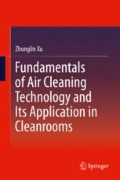Abstract
The purpose of air cleaning technology is to get rid of airborne particles as much as possible. Gaseous medium containing dispersed airborne particles is one kind of dispersed systems, which is termed as aerosol.
Access this chapter
Tax calculation will be finalised at checkout
Purchases are for personal use only
References
Ma GD, Hao JM (2003) Air pollution control engineering, 2nd edn. China Environmental Science Press, Beijing (In Chinese)
Lin ZH (1983) Sampling technique and measurement of dispersity of NaCl aerosol. Tsinghua University, Beijing (In Chinese)
JACA (1994) Guideline for the generation method of aerosol for pollution control. J Jpn Air Clean Assoc 32(2):60–83 (In Japanese)
Hinds WC (1989) Aerosol technology (trans: Sun Yufeng, Chapter 4). Heilongjiang Science and Technology Press, Harbin (In Chinese)
Yan HL, Wu HP, Zhang JK (1983) Analysis of the relationship between the average size and the polarizing fault of oil mist aerosol and its dispersity. Institute of HVAC at China Academy of Building Research, People’s Liberation Army No. 57605 of the People’s Republic of China (In Chinese)
Zhao RY, Qian BN, Xu WQ (1987) Characteristic of aerosol generator with Cold DOP aerosol. Tsinghua University, Beijing (In Chinese)
Wang JS, Zhu PK, Zhou GH et al (1983) Technical report for the development of JL leakage detection apparatus. Institute of HAVC at China Academy of Building Research, Liaoning Hongbo Radio Factory (In Chinese)
Fuchs HA (1960) The mechanics of aerosols (trans: Gu Zhenchao). Science Press, Beijing (In Chinese)
Xu ZL, Gu WZ (1980) Calculation of the minimum sampling volume for particle counter in environments with different air cleanliness levels. J HVAC 1:22–25 (In Chinese)
Yang YD (1987) Discussion of the deviation phenomena of statistical average value of particle number during measurement. In: Proceedings of the academic conference on air cleaning measurement techniques, Institute of Scientific and Technical Information at Hebei University of Technology (In Chinese)
Kamishima K (1984) Performance of ULPA filter in ultra cleanroom. Jpn Air Cond Heat Refrig News 24(1):163–172 (In Japanese)
James B (1989) Acceptance inspection of cleanroom with Class 1 (trans: Du Chunlin, Proofread by Chen Changyong). Compiler group for code for construction and acceptance of cleanroom, pp 303–304 (In Chinese)
Xu ZL (1981) Relationship between the yield and the air cleanliness level in the clean environment. Mech Eng 3(1):45–49 (In Chinese)
Yao GL (1981) Discussion of the bacterial deposition method to measure the air cleanliness level in cleanroom. Tongji University, Shanghai (In Chinese)
Sano I (1971) Generation of smoke. J Jpn Air Clean Assoc 9(5):2–11 (In Japanese)
Sato E (1971) Introduction to aerosol technology. Build Equip Water Heat Construct 9(8):47–63 (In Japanese)
Specification description of “Methods for testing the performance of airborne particle counter” (1983) Institute of HVAC at China Academy of Building Research (In Chinese)
Richard D (1981) Aerosol handbook (trans: Zhou Jinqin). Atomic Energy Press, Beijing, pp 131–132 (In Chinese)
Author information
Authors and Affiliations
Rights and permissions
Copyright information
© 2014 Springer-Verlag Berlin Heidelberg
About this chapter
Cite this chapter
Xu, Z. (2014). Particle and Size Distribution. In: Fundamentals of Air Cleaning Technology and Its Application in Cleanrooms. Springer, Berlin, Heidelberg. https://doi.org/10.1007/978-3-642-39374-7_1
Download citation
DOI: https://doi.org/10.1007/978-3-642-39374-7_1
Published:
Publisher Name: Springer, Berlin, Heidelberg
Print ISBN: 978-3-642-39373-0
Online ISBN: 978-3-642-39374-7
eBook Packages: EngineeringEngineering (R0)

